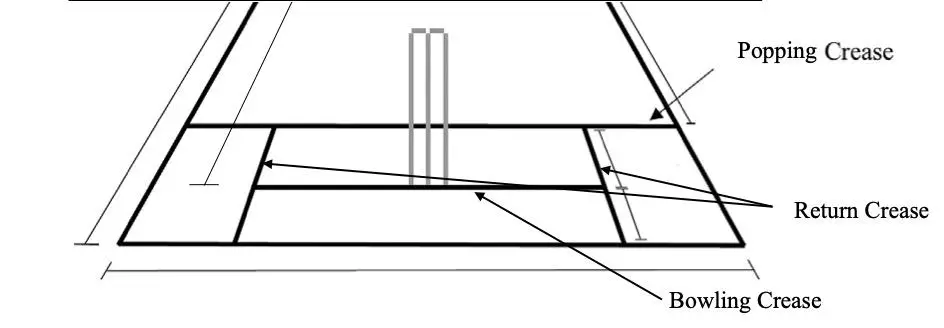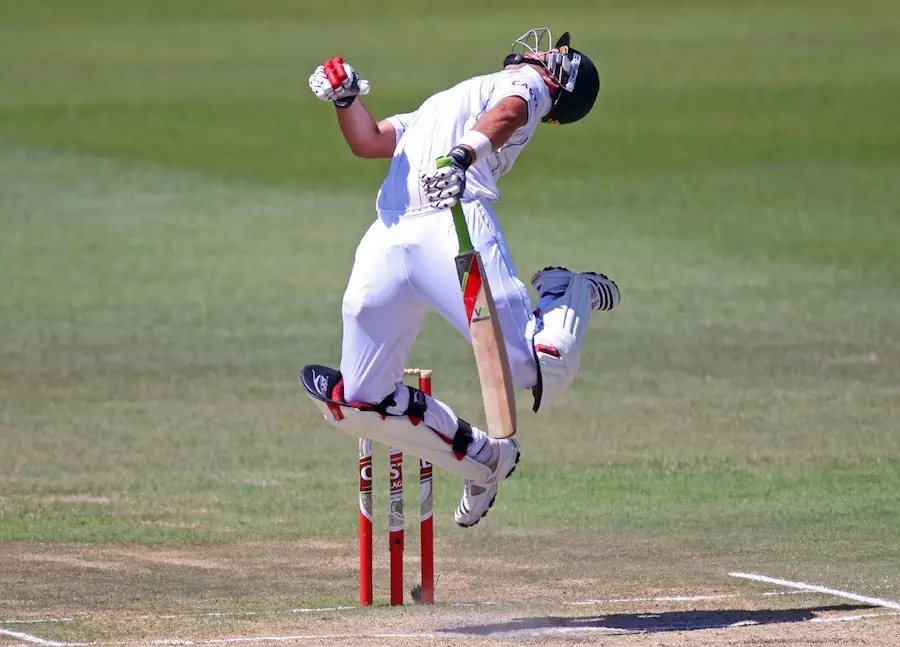Laws of cricket can be difficult to understand. No Ball rule is right up there with the LBW when it comes to the confusion it causes among the fans. The mystery of the No Ball increases at times when it is subject to umpires’ interpretation. But, in today’s post, we will help you understand the No Ball in Cricket.
A No Ball in cricket is an illegal delivery bowled by the bowler. On a No Ball, the batting team gets an extra run, the batsman can only be out in limited ways and bowler has to deliver the ball again. No Ball can also be called for an act deemed by the umpire to be unfair and/or dangerous for the batsman.
However, it isn’t always that simple as it sounds. The on-field umpires have to think about a myriad of ways on every single delivery due to which a No Ball situation may arise.
Let’s find out the intricacies of the No Ball which the MCC, the custodians of the Laws of Cricket, have explained in Law 21.
What is Considered a No Ball in Cricket?
The most common types of No Balls that are seen in a cricket match are caused due to the foot-related errors by the bowler. These are also otherwise known as Front foot or Back foot No ball. Let’s learn about them in detail –
What are Front Foot and Back Foot No Ball in Cricket?

A ball delivered by the bowler is considered a Front Foot No Ball when –
- Either some part of the bowler’s front foot, grounded or in the air, is NOT behind the popping crease when the foot makes the first contact with the ground during the bowling stride. Subsequent dragging the foot out of the popping crease is permitted.
- Or some part of the bowler’s front foot, grounded or in the air, is not on the same side of the imaginary line joining the two middle stumps.
Likewise, a Back Foot No Ball in Cricket is considered when some part of the bowler’s back foot, grounded or in the air, is not completely inside the return crease when the foot lands.
There was a time when the law was simpler in that only the back foot had to be behind the bowling crease at all times. But the practice of dragging of the front-foot well outside the popping crease, legal but unfair, by tall bowlers prompted for change in the focus mainly to popping crease instead.
There are also some other forms of no-balls that called by the Umpire. Let us also learn more about them.
Bouncer and Beamer Rules Related to No Ball
A Bouncer in Cricket is a ball that reaches the batsman at around the shoulder to head height. Bowling multiple bouncers can result in a No Ball in Cricket.

A beamer, in Cricket, is a delivery bowled by the bowler that reaches the batsman directly above the waist height and without bouncing on the pitch. Bowling multiple beamers can get the bowler banned from bowling in the rest of the Match.
According to the LAW 41 – Unfair Play, the umpire will signal a No Ball if,
- The umpire deems that the short pitch bowling, aka the bouncer, to be unfair and dangerous considering the trajectory of the ball and skills of the batsman.
- The bowler bowls non-pitching deliveries, aka the beamer, above the waist height of the striker.
- The umpire deems that the No Ball has been bowled deliberately. The bowler will be banned from bowling subsequently.
In short, it is entirely umpires’ prerogative to decide whether the act of bowling is unfair or dangerous and whether it falls under that obscure concept.
No Ball for Erroneous Mode of Delivery
A No Ball can also be called if the mode of delivery of the bowler is incorrect. There are several factors that are considered in determining the no-ball for the mode of delivery. Such type of a No Ball could be given if, the bowler –
- Fails to inform the umpire about the change in bowling arm or the side of the wicket from which he/she intends to bowl.
- Bowls underarm unless permitted by special agreement before the match.
- Throws the ball instead of bowling (which is also otherwise known as chucking)
- Breaks the wicket at bowler’s end before delivering the ball but after the completion of delivery stride.
What is the Umpire’s Signal for a No Ball?
It is important to understand when an umpire has called for a no ball. An easy way to know if the umpire has called for a no ball is to know about the signal for a No Ball.

To Signal a No Ball, the umpire simply raises one of his arms at a 90 degree angle towards the side. Usually, the choice of the arm raised depends on the side from which the bowler is bowling.
How Many Types of No Balls are there in Cricket?
There are 17 different types of No Balls in Cricket. This basically means that an umpire can call for a No Ball for 17 different reasons!
I covered all the types of No Balls exclusively in a separate post where I also mentioned some of the reasons that no many people are aware of!
In How Many Ways can a Batsman be given Out on a No Ball?
If a bowler bowls a No Ball, it also cuts down the number of ways in which a batsman can be dismissed.
There are only three ways a batsman can be given out on a No Ball. These are –
- Run Out
- Hit the ball twice and
- Obstructing the field.
Thus, when a batsman detects an early No Ball call from the umpire, he/she can choose to go for big shots with impunity devoid of any fear of being dismissed.
What is the Penalty for a No Ball?
If a No Ball is bowled by the bowler, or if a No Ball is called by the umpire for any of the 17 possible reasons, an extra run is awarded to the batting team in addition to any other runs scored (from the bat, bye or leg bye), and any other runs awarded for penalties.
Furthermore, the ball will have to re-bowled and will not be counted as one from the over. Additionally, irrespective of whose mistake it was or how intended it was, a No Ball is always debited against the bowler. This means that the number of runs conceded by a bowler will always increase if a No Ball is called by the Umpire.
The bowling team also get penalised in the number of ways they can dismiss a batsman on a No Ball.
In the limited overs cricket format, a No Ball also results in a Free Hit (which we shall talk about more in detail later).
What is a Free Hit? How is it Related to a No Ball?
A Free Hit in Cricket is the subsequent delivery bowled by the bowler after a No Ball has been called by the Umpire. There are limited ways in which a batsman can be given OUT on a Free HIt. Unlike a No Ball, it is counted as one for the over. Free Hit is only given in Limited Overs Cricket.
If a No ball has been called by the Umpire during an ODI or a T20 match, the batting team gets a Free Hit on the very next delivery after a No Ball. Free Hit, unlike a No Ball, is considered one of the over, however, the batsman can only be dismissed in the modes similar to the ones allowed on a No Ball.
A Free Hit gives an opportunity to break the shackles since the batsman gets the license hit out without fear. The batsman is also aware of the opportunity before the ball is even bowled, thereby, giving him/her the confidence to hit the ball for a boundary on a Free Hit.
What is an Auto-No Ball?
The Auto-No Ball has been one of the most recent developments in Cricket. The auto-no ball was first tried in late 2019 during the ODI and T20I series between India and the West Indies.
The idea using the Auto-No Ball is to completely rid the on-field umpires from deciding on the front or back foot No Balls. The third umpire would check that for every delivery and would promptly inform the on-field umpires of any such transgression by the bowler.
Although it seems to be a good method to aid umpires and to improve the decision making amongst the umpires at the bowler’s end, critics believe that it may slow down the game.
Is the third umpire consulted for a No Ball?
A third umpire is not always consulted for a No Ball. In most usual cases, a no ball is directly considered when signalled by the on-field umpire.
ICC, however, introduced the UDRS or the Umpire Decision Review System (also commonly known as DRS) to augment the LBW decision making. Upon taking the DRS, a mandatory No Ball check is done for all decisions being reviewed.
This is done to check whether the delivery was a legal delivery. There have been instances in the past when the umpires have missed the No Ball and had given the batsman as ‘Out’. However, when reviewed, such decisions have had to be overturned.
Umpires, at times, can be blinded by the bowling action of certain bowlers. Thus, it has been a regular practice, in the last couple of years, to refer to the third umpire after a dismissal when the on-field umpire is not sure about No Ball.
Final Thoughts
I hope after reading this article you would know intricacies of the No Ball and the abundance of circumstances that the umpires have to consider before adjudicating one. No Ball often makes an appearance in nervous situations when the bowlers are most vulnerable. It has the potential to turn the tables. It adds to the drama that is cricket.
